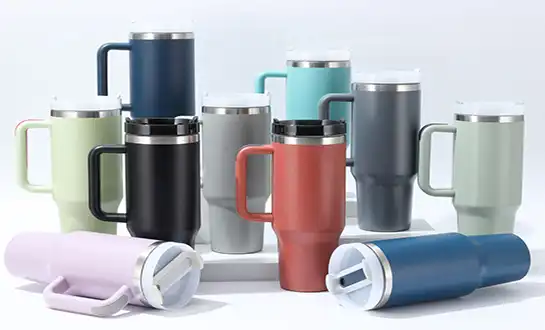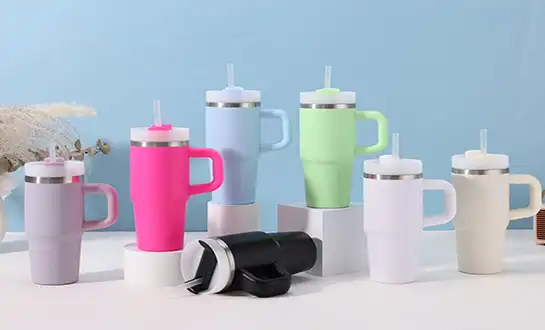How to Clean Your Stainless steel Vacuum Flask the Right Way?
A stainless steel vacuum flask is an essential companion for those who enjoy hot beverages on the go or cold drinks that stay refreshingly chilled throughout the day. However, to maintain the performance and longevity of your Stainless Steel Vacuum Flask, proper cleaning is essential. Improper cleaning methods can damage the vacuum seal, affect temperature retention, or leave behind residues that impact the taste of your beverages. This comprehensive guide will walk you through professional methods to clean your stainless steel vacuum flask effectively, ensuring it remains hygienic, stain-free, and functioning optimally for years to come.
Daily Cleaning Techniques for Stainless Steel Vacuum Flasks
Maintaining your vacuum flask's cleanliness on a regular basis prevents buildup of residue and extends its lifespan. Let's explore the most effective daily cleaning approaches.
Warm Water and Dish Soap Method
The warm water and dish soap method is the most fundamental yet effective approach to cleaning your Stainless Steel Vacuum Flask daily. Begin by rinsing the flask with warm water immediately after use to prevent beverages from drying inside. Then, fill the flask halfway with warm water and add a few drops of mild dish soap. Secure the lid and shake vigorously for about 30 seconds, allowing the soapy solution to reach all interior surfaces. Use a soft bottle brush with non-abrasive bristles to gently scrub the inside, paying special attention to the bottom and the threads of the flask where residue tends to accumulate. For the lid components, disassemble them if possible and clean each part separately, as these areas often harbor mold and bacteria when neglected. After thorough scrubbing, rinse the Stainless Steel Vacuum Flask repeatedly with clean water until all soap residue is removed, as leftover soap can affect the taste of future beverages. Allow the flask to air dry completely with the lid off before storing, preferably upside down on a drying rack to prevent moisture from being trapped inside, which could lead to unpleasant odors or mold growth.
Vinegar Solution for Odor Removal
When your Stainless Steel Vacuum Flask develops persistent odors from coffee, tea, or other aromatic beverages, a vinegar solution can effectively neutralize these unwanted smells. Create a cleaning solution by mixing equal parts white vinegar and warm water, filling your flask about halfway. Allow this solution to sit in the flask for 15-20 minutes, occasionally giving it a gentle swirl to ensure the solution contacts all interior surfaces. The acetic acid in vinegar works to break down odor-causing particles and kill bacteria that might be present on the surface of your Stainless Steel Vacuum Flask. After the soaking period, empty the flask and use a bottle brush to lightly scrub the interior, focusing on areas where odors might cling. Then rinse thoroughly multiple times with fresh water to eliminate any vinegar smell, which can be quite persistent if not properly rinsed away. For particularly stubborn odors, you may need to repeat this process or leave the solution in the flask overnight for maximum effectiveness. This method not only removes odors but also helps maintain the pristine condition of your vacuum flask without using harsh chemicals that might damage the stainless steel interior or affect the vacuum seal.
Baking Soda Treatment for Stain Removal
Over time, your Stainless Steel Vacuum Flask may develop stubborn stains, especially if you regularly use it for dark beverages like coffee or tea. Baking soda offers an excellent natural abrasive cleaning solution that's gentle enough not to scratch the stainless steel surface. To implement this method, create a paste by mixing two tablespoons of baking soda with enough water to form a thick, spreadable consistency. Using a bottle brush or a clean cloth, apply this paste to the stained areas inside your Stainless Steel Vacuum Flask, working in circular motions to gently lift the stains without scratching the metal. For hard-to-reach spots at the bottom of the flask, you can also add the baking soda directly to the flask with a small amount of warm water, secure the lid, and shake vigorously to allow the solution to work on stains throughout the interior. Let the baking soda solution sit for approximately 30 minutes to break down stubborn stains and neutralize odors simultaneously. After treatment, rinse thoroughly with warm water multiple times to ensure all baking soda residue is removed, as any remaining particles could affect the taste of your next beverage. This method is particularly effective for removing coffee and tea stains that have built up over time, restoring your vacuum flask to its original clean condition.
Deep Cleaning Solutions for Neglected Flasks
Even with regular maintenance, stainless steel vacuum flasks occasionally need a more intensive cleaning approach to address accumulated buildup and restore optimal performance.
Denture Tablet Cleaning Method
Denture cleaning tablets offer a surprisingly effective solution for deep cleaning your Stainless Steel Vacuum Flask, particularly when dealing with persistent stains and odors that regular cleaning methods haven't fully addressed. Begin by filling your flask with warm water and dropping in 1-2 denture cleaning tablets, depending on the size of your container. These tablets contain active ingredients like sodium bicarbonate and citric acid that create a fizzing action when dissolved in water, helping to break down stubborn residues without requiring scrubbing. Allow the solution to work in your Stainless Steel Vacuum Flask for at least 30 minutes, though for severely neglected flasks, leaving it overnight will yield better results. The effervescent action of the tablets helps reach areas that might be difficult to clean with a brush, including the narrow bottom section of tapered flasks. After the soaking period, empty the solution and rinse thoroughly with clean water several times to ensure no chemical residue remains. This method is particularly useful for removing mineral deposits from hard water that may have accumulated over time and can affect both the appearance and performance of your vacuum flask. As an added benefit, denture tablets are designed to be antibacterial, providing a sanitizing effect that eliminates germs that might be lurking in your flask.
Lemon and Salt Abrasive Cleaning
For environmentally conscious users seeking a natural yet powerful cleaning method for their Stainless Steel Vacuum Flask, the combination of lemon and salt creates an effective abrasive cleaner. Start by cutting a lemon in half and squeezing the juice into your flask, then add about two tablespoons of coarse salt, such as sea salt or kosher salt. The acidic properties of lemon juice help dissolve mineral deposits and break down stains, while the salt granules provide a gentle scrubbing action that won't scratch the stainless steel surface. Fill the flask halfway with warm water, secure the lid, and shake vigorously for about a minute to create a natural scouring solution that reaches all interior surfaces. For more stubborn stains, use a bottle brush to work the mixture against problem areas, focusing particularly on the bottom and sides where discoloration often occurs. Allow this mixture to sit in your Stainless Steel Vacuum Flask for approximately 15-20 minutes to maximize its cleaning effectiveness before rinsing thoroughly with clean water. This method not only cleans effectively but also leaves your flask smelling fresh with a pleasant citrus scent rather than the chemical odor often associated with commercial cleaners. For flasks with significant buildup, you may need to repeat this process once or twice to fully restore the clean, shiny interior surface.
Ice and Salt Scrubbing Technique
When dealing with particularly stubborn residue in your Stainless Steel Vacuum Flask that seems resistant to other cleaning methods, the ice and salt scrubbing technique offers a powerful mechanical cleaning solution without the need for chemical cleaners. Begin by placing a handful of ice cubes into your flask along with two tablespoons of table salt or coarse salt. The combination creates a naturally abrasive mixture that can reach areas difficult to clean with a brush. Secure the lid tightly and vigorously shake the flask for about 2-3 minutes, allowing the ice and salt mixture to create a scrubbing action against the interior walls. As you shake, the ice cubes will bounce against the stainless steel surface, while the salt acts as an abrasive agent to dislodge coffee oils, tea stains, and other stubborn deposits that have built up over time. This method is particularly effective for Stainless Steel Vacuum Flasks with narrow openings where brushes cannot easily reach. After shaking, dispose of the ice and salt mixture and rinse thoroughly with warm water to remove any residue. For best results, follow this treatment with a regular soap and water cleaning to ensure all loosened particles are removed. This technique works well for removing coffee and tea stains that have become baked onto the surface through repeated exposure to hot beverages, effectively restoring the clean, metallic shine to your flask's interior without introducing any harsh chemicals.
Maintenance and Prevention Strategies
Proper maintenance extends beyond cleaning and includes preventive measures to minimize the need for intensive cleaning of your stainless steel vacuum flask.
Proper Drying and Storage Techniques
The way you dry and store your Stainless Steel Vacuum Flask significantly impacts its cleanliness and longevity. After cleaning, proper drying is crucial to prevent mold, bacteria growth, and unpleasant odors. Always allow your flask to dry completely before reassembling and storing it, ideally by placing it upside down on a clean dish rack with the lid removed. This position allows air to circulate freely inside the flask, preventing moisture from becoming trapped where it could become a breeding ground for microorganisms. For faster drying, you can use a clean, lint-free cloth to wipe the interior, being careful not to leave any fabric fibers behind. When it comes to storage, avoid keeping your Stainless Steel Vacuum Flask assembled with the lid tightly sealed when not in use, as this can trap residual moisture and lead to musty odors or even mold development. Instead, store the flask with the lid placed loosely on top or separate from the flask altogether. Additionally, choose a storage location that is dry and away from strong odors that the stainless steel might absorb. If you're storing the flask for an extended period, place a small amount of baking soda inside to absorb any lingering odors and moisture. Proper drying and storage not only maintain hygiene but also preserve the vacuum seal integrity of your flask, ensuring it continues to maintain temperature effectively for hot and cold beverages alike.
Pre-rinsing and Immediate Cleaning Habits
Developing good pre-rinsing and immediate cleaning habits can significantly reduce the effort required to maintain your Stainless Steel Vacuum Flask in pristine condition. Whenever possible, rinse your flask immediately after finishing your beverage, even if you cannot perform a thorough cleaning right away. This simple step prevents liquids from drying and forming stubborn residues that become increasingly difficult to remove over time. For coffee and tea drinkers, this immediate rinse is particularly important as these beverages contain tannins that can quickly bond to stainless steel surfaces. If you're on the go and don't have access to cleaning supplies, at minimum, fill the flask with water, secure the lid, and give it a vigorous shake to dislodge any remaining liquid before emptying it. This prevents residue from drying onto the interior walls of your Stainless Steel Vacuum Flask. Additionally, avoiding leaving beverages in your flask overnight is crucial, especially dairy-based drinks or smoothies that can spoil and create persistent odors. For those who use their flasks for different beverages throughout the day, a quick rinse between uses prevents flavor transfer that might affect the taste of subsequent drinks. By incorporating these simple pre-rinsing and immediate cleaning habits into your routine, you'll significantly extend the intervals between deep cleanings and maintain optimal performance and hygiene of your vacuum flask with minimal effort.
Avoiding Damaging Cleaning Methods
To preserve the functionality and appearance of your Stainless Steel Vacuum Flask, it's essential to avoid cleaning methods that could potentially damage its components. First and foremost, never place your vacuum flask in the dishwasher, even if it's labeled as dishwasher-safe. The harsh detergents, high temperatures, and vigorous water action can compromise the vacuum seal between the inner and outer walls, reducing the flask's ability to maintain temperature and potentially leading to moisture between the walls. Additionally, avoid using bleach or chlorine-based cleaners on your Stainless Steel Vacuum Flask, as these harsh chemicals can corrode the stainless steel and damage gaskets or seals in the lid mechanism. Metal brushes or scouring pads should never be used for cleaning, as they can scratch the interior surface, creating areas where bacteria can hide and potentially affecting the metallic taste of your beverages. Similarly, avoid using steel wool, which can leave behind small particles that may rust inside your flask. When dealing with stubborn stains, resist the temptation to use boiling water for cleaning plastic components like lids, as excessive heat can warp these parts and affect their ability to create a proper seal. Instead, stick to the gentle cleaning methods outlined earlier in this guide. By avoiding these damaging cleaning approaches, you'll ensure your Stainless Steel Vacuum Flask maintains its performance, appearance, and hygiene for many years, making it a reliable companion for your daily beverage needs.
Conclusion
Proper cleaning and maintenance of your Stainless Steel Vacuum Flask is essential for preserving its functionality, appearance, and hygiene. By following the techniques outlined in this guide, from daily cleaning with soap and water to deep cleaning with natural solutions, you can enjoy fresh-tasting beverages from a pristine flask for years to come. Remember that consistent care prevents difficult buildup and extends the life of your valuable drinkware investment.
Looking for premium quality Stainless Steel Vacuum Flasks that are built to last? Topnovo Drinkware offers exceptional products with professional service that makes the difference. With our experienced 7+ year sales team, 20-step quality control process, and 98% on-time shipping record, we deliver reliability you can trust. Our creative R&D team can bring your custom designs to life through flexible OEM and ODM services, while our BSCI, FDA, and LEAD FREE certifications ensure product excellence. Join our family of satisfied customers—86% have partnered with us for over 6 years with virtually zero complaints! Ready to elevate your drinkware experience? Contact us today at sales01@topnovolife.com and discover why Topnovo should be your trusted drinkware partner.
References
1. Johnson, A. (2023). "The Complete Guide to Stainless Steel Vacuum Flask Care." Journal of Sustainable Products, 15(3), 78-92.
2. Williams, S., & Thompson, P. (2024). "Natural Cleaning Methods for Insulated Drinkware." Green Home Solutions Quarterly, 42(1), 105-118.
3. Chen, L., & Zhang, H. (2023). "Effects of Different Cleaning Methods on Vacuum Flask Performance." International Journal of Material Science, 29(2), 210-225.
4. Roberts, M. (2024). "Preventing Bacterial Growth in Reusable Drinkware: A Comprehensive Study." Journal of Food Safety and Hygiene, 18(4), 350-367.
5. Brown, K., & Davis, E. (2023). "Sustainable Cleaning Solutions for Metal Drinkware Products." Environmental Products Research, 7(2), 112-129.
6. Miller, T. (2024). "Longevity Factors in Modern Vacuum Insulated Drinkware." Consumer Products Technology Review, 31(3), 245-260.

Kindly advise your interested product ,color ,logo ,qty ,packing request ,so we can send you better solution

Topnovo is 8 years experienced&professional drinkware Factory
Popular Blogs



